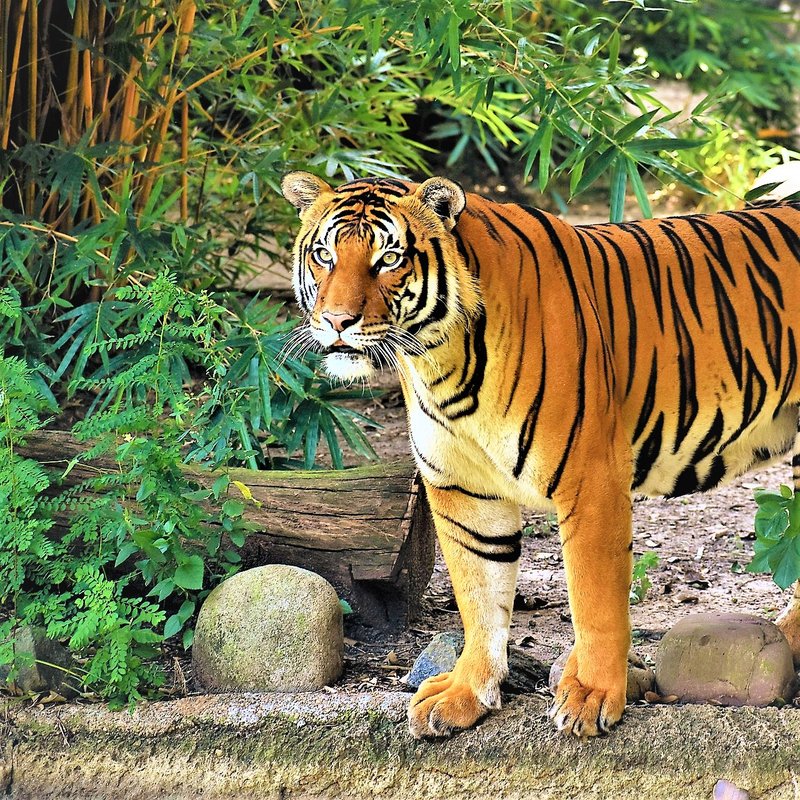
In Malaysia and surrounding regions, the Malayan tiger is more than just a predator; it’s a critical influencer on various species, vegetation, and the overall health of the ecosystems they inhabit. From regulating prey populations to supporting diverse plant life, these tigers are deeply intertwined with their surroundings. So, let’s dive into their fascinating role in the ecosystem, unraveling the intricate web of life in which they play a starring role.
Understanding Ecosystem Dynamics
Ecosystems are like communities where various organisms interact with one another and their environment. You can think of it as a complex puzzle—each piece has its unique shape and function. The Malayan tiger is one of the apex predators in its ecosystem, meaning it sits at the top of the food chain.
Apex predators, like the Malayan tiger, help regulate the populations of other animals, especially herbivores such as deer and wild boar. This regulation is vital because when herbivore numbers grow unchecked, they can overgraze the vegetation. Overgrazing can lead to habitat destruction, which in turn affects many other species that rely on plants for food and shelter.
In essence, the presence of the Malayan tiger is crucial for keeping the numbers of these herbivores in check and ensuring that the lush jungles of Malaysia remain thriving and diverse. Without them, the balance of life would tip, causing ripples of change throughout the entire ecosystem.
The Role of Predation
Predation is a natural process where one organism hunts another for food. This might sound harsh, but it’s a fundamental aspect of a healthy ecosystem. The Malayan tiger, as a skilled hunter, plays a key role in this process.
Honestly, when tigers prey on herbivores, they indirectly support plant life too. By controlling the herbivore populations, tigers allow young and less competitive plants to grow. For instance, if deer populations explode because there are no predators, these critters can easily munch through young shoots, limiting tree and plant regeneration.
It’s fascinating, isn’t it? By simply being a tiger and doing what they do best, these animals help shape the landscape around them, promoting biodiversity. Whenever you think of a tiger lounging in the sun, remember that it’s not just resting; it’s actively contributing to a healthier environment.
Impact on Biodiversity
Biodiversity refers to the variety of life in a particular ecosystem. You might be wondering why biodiversity matters so much. Well, it’s like having a library filled with different books; the more diverse the collection, the better equipped you are to learn and adapt.
The Malayan tiger helps maintain biodiversity by ensuring that various species can coexist. When tiger numbers are stable, the balance of predator and prey is upheld. This stability allows different species of plants and animals to thrive. In contrast, if tiger populations drop significantly, we can see a cascading effect: herbivore populations might surge, leading to reduced plant diversity and habitat degradation.
Moreover, a diverse ecosystem is more resilient. It can better handle changes, such as climate shifts or disease outbreaks. So, by protecting the Malayan tiger, we’re also safeguarding countless other species and the rich tapestry of life they support.
Conservation Challenges
Unfortunately, the Malayan tiger faces numerous challenges that threaten its survival. Habitat loss due to deforestation, urban development, and illegal poaching have all contributed to a significant decline in tiger numbers. Let me explain how this impacts their role in the ecosystem.
When tiger habitats shrink, they can’t hunt effectively. This leads to a rise in herbivore populations, which, as we’ve discussed, can result in overgrazing and a reduction in plant diversity. Moreover, the fragmentation of their habitat means that tigers are more likely to come into conflict with humans. This can lead to tragic outcomes for both the tigers and local communities.
Conservation efforts are crucial to ensure that these beautiful creatures remain part of the ecosystem. Protecting their habitat, enforcing anti-poaching laws, and raising awareness about their importance can make a significant difference. After all, when we invest in their future, we’re also investing in the health of the entire ecosystem.
How Local Ecosystems Benefit from Malayan Tigers
It’s important to realize that the benefits of Malayan tigers extend beyond the immediate environment. The presence of these big cats can positively influence local communities and economies as well. You might not think of tigers as economic assets, but here’s the thing: ecotourism thrives in regions where wildlife is preserved.
When people travel to see the Malayan tiger in its natural habitat, they contribute financially to conservation efforts. Local economies benefit from tourism dollars, which can help promote programs that protect not only the tigers but the entire ecosystem. This creates a win-win situation: wildlife thrives, and communities prosper.
Additionally, having healthy tiger populations can improve ecosystem services that humans rely on, such as clean water and air quality. By maintaining the balance of nature, tigers ultimately support our well-being too.
Supporting Malayan Tiger Conservation
So, how can you support the conservation of the Malayan tiger? There are actually several ways to get involved, no matter where you are in the world.
- Educate yourself: Learn more about the challenges facing these magnificent creatures and share what you find with friends and family.
- Support conservation organizations: Many groups focus on protecting tigers and their habitats. Donating or volunteering can make a real difference.
- Participate in ecotourism: If you’re traveling to Southeast Asia, consider visiting national parks or reserves where you can see Malayan tigers in their natural environment. Choose reputable guides who prioritize conservation.
- Advocate for wildlife protection: Use your voice to promote policies that support wildlife conservation and habitat protection.
Every small action counts, and collective efforts can lead to significant positive changes for the Malayan tiger and the ecosystems they inhabit.
The Malayan tiger is more than just a striking figure in the wild; it’s a keystone species that plays a vital role in its ecosystem. From regulating herbivore populations to promoting biodiversity, these tigers have a profound impact on their surroundings.
As we face ongoing challenges like habitat loss and climate change, it’s critical to prioritize the conservation of the Malayan tiger. By understanding their importance and taking action to protect them, we can ensure that future generations will continue to benefit from the health and richness of the ecosystems they help sustain.
Let’s commit to being stewards of the environment, recognizing that every creature has its place in the intricate web of life. Together, we can create a future where both humans and Malayan tigers thrive.

